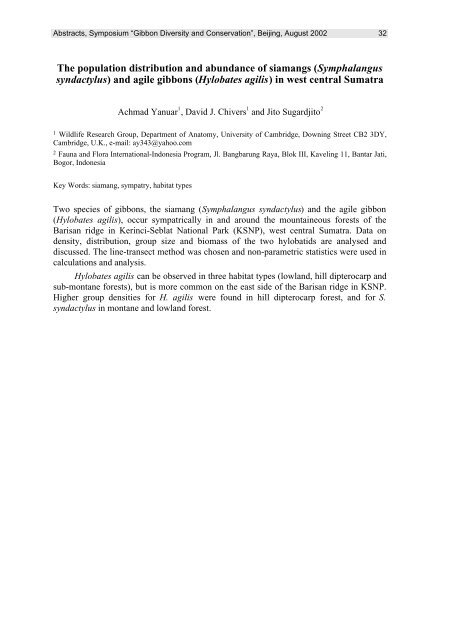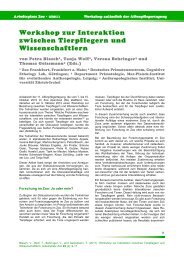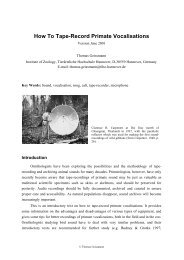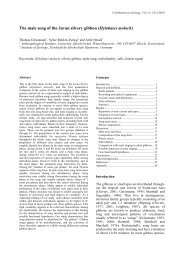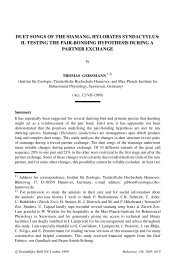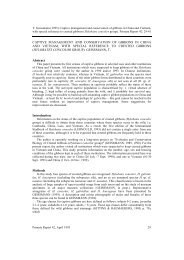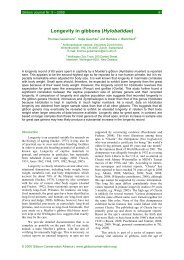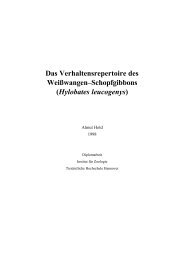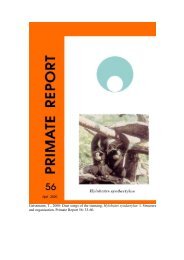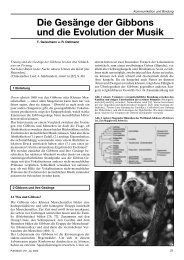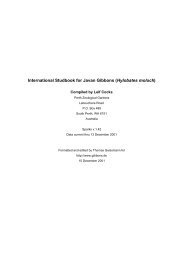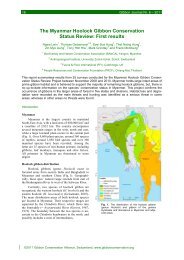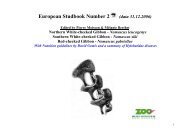Abstracts, Symposium “<strong>Gibbon</strong> Diversity and Conservation”, Beijing, August 2002 31The survey project for captive gibbons in Taiwan and South-east AsiaCi-Wen Yang 1 , Hou-Chun Chen 1 , Po-Chung Chang 1 and Kuang-Yu Hu 21Taipei Zoo, Taiwan, 30 Sec.2 Hsin Kuang Road, Taipei, Taiwan, R.O.C., e-mail: dwx10@zoo.gov.tw2National Defense Medical College, Taipei Taiwan.R.O.C., e-mail: kyhu@ndmctsgh.edu.twKey Words: gibbon identification, DNA, vocalIn 1993, the Taipei Zoo surveyed the gibbons in Taiwan and located 77 Hylobates lar, 3 H.moloch, 3 H. muelleri, 8 H. pileatus, 2 Bunopithecus hoolock, 11 Nomascus spp., and 3Symphalangus syndactylus, totaling 166 gibbons. During that survey, the local governmentdid not have accurate means to identify gibbon species.The Taipei Zoo cooperated with the National Defense Medical College of R.O.C. toinitiate the project “Phylogenetic analysis of gibbons at Taipei Zoo” in August, 1999.During that project, we collected hairs and blood for DNA analysis. The molecularindicated that 30 gibbons at the Taipei Zoo were 4 Hylobates agilis, 17 H. lar, 4 H.muelleri, 1 Nomascus leucogenys, 2 N. gabriellae, 1 Symphalangus syndactylus, and onegibbon with ambivalent sequence data. In addition, 1 gibbon housed outside the Taipei Zoowas 1 H. muelleri, and 2 captive gibbons at Shanghai Zoological Park were 2 N.leucogenys.During a survey in 2000, we collected hairs and blood for molecular analysis andobtained photographs of gibbon fur coloration from additional zoos and conservationcenters in Taiwan. In 2001, Alan Mootnick assisted a morphological survey of the gibbonshoused at the Taipei Zoo and zoos in the northern region. Our surveys include 111 captivegibbons in Taiwan.During surveys in 2002, we will tape-record song bouts of the gibbons housed inTaiwan; these will be identified by Thomas Geissmann in Germany. In cooperation withzoos in Indonesia, Malaysia, Singapore and Thailand, we have begun surveying the captivegibbons of the South East Asian Zoos Association (SEAZA). The Taipei Zoo plans toestablish a comprehensive database of the captive gibbon populations in South-east Asiaincluding molecular data, vocal data and fur coloration data. This data base could serve asan important tool for ex-situ gibbon conservation.
Abstracts, Symposium “<strong>Gibbon</strong> Diversity and Conservation”, Beijing, August 2002 32The population distribution and abundance of siamangs (Symphalangussyndactylus) and agile gibbons (Hylobates agilis) in west central SumatraAchmad Yanuar 1 , David J. Chivers 1 and Jito Sugardjito 21Wildlife <strong>Research</strong> Group, Department of Anatomy, University of Cambridge, Downing Street CB2 3DY,Cambridge, U.K., e-mail: ay343@yahoo.com2Fauna and Flora International-Indonesia Program, Jl. Bangbarung Raya, Blok III, Kaveling 11, Bantar Jati,Bogor, IndonesiaKey Words: siamang, sympatry, habitat typesTwo species of gibbons, the siamang (Symphalangus syndactylus) and the agile gibbon(Hylobates agilis), occur sympatrically in and around the mountaineous forests of theBarisan ridge in Kerinci-Seblat National Park (KSNP), west central Sumatra. Data ondensity, distribution, group size and biomass of the two hylobatids are analysed anddiscussed. The line-transect method was chosen and non-parametric statistics were used incalculations and analysis.Hylobates agilis can be observed in three habitat types (lowland, hill dipterocarp andsub-montane forests), but is more common on the east side of the Barisan ridge in KSNP.Higher group densities for H. agilis were found in hill dipterocarp forest, and for S.syndactylus in montane and lowland forest.
- Page 1 and 2: Thomas GeissmannInstitut für Zoolo
- Page 3 and 4: Symposium “Gibbon Diversity and C
- Page 5 and 6: Abstracts, Symposium “Gibbon Dive
- Page 7 and 8: Abstracts, Symposium “Gibbon Dive
- Page 9 and 10: Abstracts, Symposium “Gibbon Dive
- Page 11 and 12: Abstracts, Symposium “Gibbon Dive
- Page 13 and 14: Abstracts, Symposium “Gibbon Dive
- Page 15 and 16: Abstracts, Symposium “Gibbon Dive
- Page 18 and 19: Abstracts, Symposium “Gibbon Dive
- Page 20 and 21: Abstracts, Symposium “Gibbon Dive
- Page 22 and 23: Abstracts, Symposium “Gibbon Dive
- Page 24 and 25: Abstracts, Symposium “Gibbon Dive
- Page 26 and 27: Abstracts, Symposium “Gibbon Dive
- Page 28 and 29: Abstracts, Symposium “Gibbon Dive
- Page 30 and 31: Abstracts, Symposium “Gibbon Dive
- Page 32 and 33: Abstracts, Symposium “Gibbon Dive


